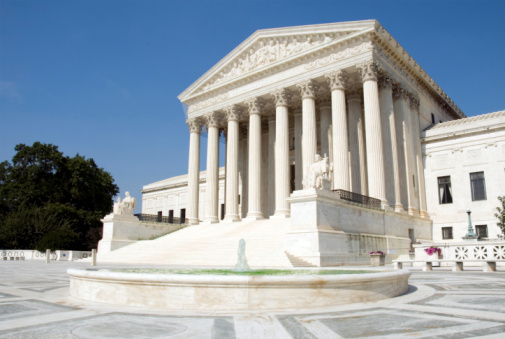
Recent Court decisions have not created a presumption in favor of formal cost-benefit analysis.
In the wake of the U.S. Supreme Court’s opinion in Michigan v. EPA last term, a number of commentators have revived talk of something called the “Cost Benefit State.” It is supposed to be a good thing, although it makes some of us shudder. The phrase was originally coined by Cass Sunstein in a 2002 book by that name. It describes a supposedly utopian government in which agencies and courts apply to all regulatory decision-making a formal cost-benefit analysis (CBA) grounded in welfare economics.
Sunstein and other eager proponents of CBA have seized on language in the Michigan case that, in the course of striking down the U.S. Environmental Protection Agency’s (EPA) mercury rule, gestured toward the existence of a presumption favoring the consideration of costs in regulatory decision-making. Sunstein heralded the opinion as a “rifle shot” ringing in the arrival of the Cost-Benefit State. And John Graham and Paul Noe, in a recent The Regulatory Review essay, echoed that sentiment, congratulating the Court on reversing its earlier anti-CBA presumption.
Indeed, in the midst of all of this hoopla, the casual observer might be forgiven for assuming that the Toxic Substances Control Act reform legislation signed into law by President Barack Obama last month is a further instantiation of the same principle. It does, after all, require EPA to consider costs and benefits before setting new rules for toxic substances.
But no matter how much Sunstein, Graham, and Noe might wish it were so, the Cost-Benefit State is—thankfully—not here. The consideration of costs that the Court endorsed in Michigan is not synonymous with formal cost-benefit analysis.
Agencies have many ways of considering costs in regulatory decision-making that are entirely distinct from CBA. Congress has frequently, for example, directed agencies to set environmental standards through the use of feasibility analysis. This kind of analysis considers costs in order to identify the most stringent level of environmental protection that is economically and technologically feasible but does not balance costs against benefits, as CBA does.
Cost-effectiveness analysis—another common tool used by agencies—considers costs but does not involve CBA either. It takes a single regulatory goal (like saving a human life) and compares the costs of reaching that goal under various regulatory alternatives.
Consequently, when the Supreme Court suggests a presumption in favor of considering costs, as it did in Michigan, that is a very different matter from the Court endorsing a presumption in favor of formal cost-benefit analysis, as Sunstein, Graham, and Noe claim.
Even CBA itself comes in many forms—from an informal, intuitive balancing of qualitatively described pros and cons, to a formal, quantified method grounded in welfare economics. Congress and the courts have generally favored the informal kind. But the CBA that Sunstein, Graham, and Noe envision for their Cost-Benefit State is well toward the formal end of the spectrum. At its most formal, CBA requires quantifying and monetizing all of the social costs and benefits of a regulation and a host of incrementally varying alternatives, discounting these costs and benefits to present value, and finding the point where the marginal cost curve intersects the marginal benefits curve so as to maximize net benefits. This is the kind of CBA contemplated by the executive orders adopted by Presidents Bill Clinton and Obama and typically demanded by the White House Office of Information and Regulatory Affairs (OIRA). It is also the kind that has generated enormous controversy for decades because it requires putting a dollar value on intangibles—like good health and a clean environment—that are impossible to measure in monetary terms.
Informal CBA, on the other hand, is an entirely different matter. Simply weighing pros and cons that are qualitatively described is usually unobjectionable even to the most fervent critics of formal cost-benefit analysis. It is how Ben Franklin said he made big decisions, and what could be more unobjectionable than Ben Franklin?
The controversies surrounding formal, monetized CBA led the Supreme Court to apply a presumption against CBA in a number of cases in the 1980s, 1990s, and early 2000s. So its 2009 decision in Entergy v. Riverkeeper, upholding EPA’s cooling water rule for power plants, marked the first time the Court had ever upheld an environmental agency’s use of CBA. This was a big deal. But Graham and Noe’s characterization of this opinion as one that “nullified” the Court’s earlier anti-CBA presumption is an overstatement.
The Court was careful in Riverkeeper to confine its endorsement of CBA to the most informal varieties and actually went out of its way to express skepticism about more formal brands of CBA. Justice Scalia, writing for the majority, suggested that formal CBA “might be precluded.” And Justice Breyer elaborated on this sentiment in a concurring opinion, warning the agency to “avoid lengthy formal cost-benefit proceedings and futile attempts at comprehensive monetization.” Thus, to the extent the preexisting anti-CBA presumption encompassed informal as well as formal varieties of CBA (which was unclear from those earlier cases), Riverkeeper certainly marks a departure because it allowed the agency to read an ambiguous statute to permit informal CBA. But at the same time, the Court left the door wide open on a continuing presumption against formal CBA.
Graham and Noe also overstate their case when they read Riverkeeper as creating a new pro-CBA presumption under which an agency must provide “a reasoned explanation” if it wishes to proceed with a regulation for which monetized costs exceed monetized benefits, or—in their words—if an agency “should choose to regulate in a way that would do more harm than good.” Sunstein makes a similar argument in a recent article. But the Court stopped far short of embracing any pro-CBA presumption in Riverkeeper. Notably, the Court did not require agency use of CBA at all. It merely gave EPA discretion to use an informal CBA if it chooses to, but it left the agency free to choose other forms of analysis entirely.
Nor did last term’s decision in Michigan v. EPA close the door to a presumption against formal CBA or create a new pro-CBA presumption. While the Court suggested that agencies should generally consider costs in regulatory decision-making, it also made clear that that “it will be up to the agency to decide . . . . how to account for cost.” Thus, while it is possible to read Michigan as gesturing toward a presumption in favor of cost consideration, as we have seen, that is a very different matter from the kind of presumption in favor of formal CBA that would herald the dawning of the Cost-Benefit State. Indeed, in Michigan, both the majority and the dissent took pains to make clear that they were not requiring agencies “to conduct a formal cost-benefit analysis in which each advantage and disadvantage is assigned a monetary value.”
That same disclaimer might well apply to the recent Toxic Substances Control Act reform legislation, where Congress was careful not to specify formal CBA. The new statute simply directs EPA to “consider . . . costs and benefits.” An informal, qualitative CBA would presumably comply with this directive. Arguably, so would cost-effectiveness and feasibility analysis.
Ultimately, the fallacy in Graham and Noe’s argument is the unsupported assumption that a formal CBA actually tells us whether a regulation will “do more harm than good.” Even putting aside the myriad theoretical difficulties that have plagued formal CBA for decades, it is becoming increasingly clear that, from a practical perspective, we simply do not have anywhere near the data and scientific understanding necessary even to begin to quantify the myriad harms that our regulations aim at lessening. An empirical study that I am currently finishing makes this point in stark terms: In over three-quarters of its CBAs of economically significant rules from Oct., 1, 2002 through September 30, 2012, EPA has been unable to quantify whole categories of benefits that the agency itself describes as “important,” “significant,” or “substantial.”
When significant categories of benefits are regularly left out of the calculation, it is not at all clear that formal CBA is even capable of telling us whether a regulation will do more harm than good. Worse yet, it is likely to grossly mislead us—making a regulation that in fact delivers more good than harm appear to do the opposite. Fortunately, the Supreme Court still recognizes the dangers of formal CBA, and most of our environmental statutes still direct agencies to use other more sensible tools for regulatory decision-making.
This essay is part of The Regulatory Review‘s three-part series, A Debate Over the Use of Cost-Benefit Analysis.




